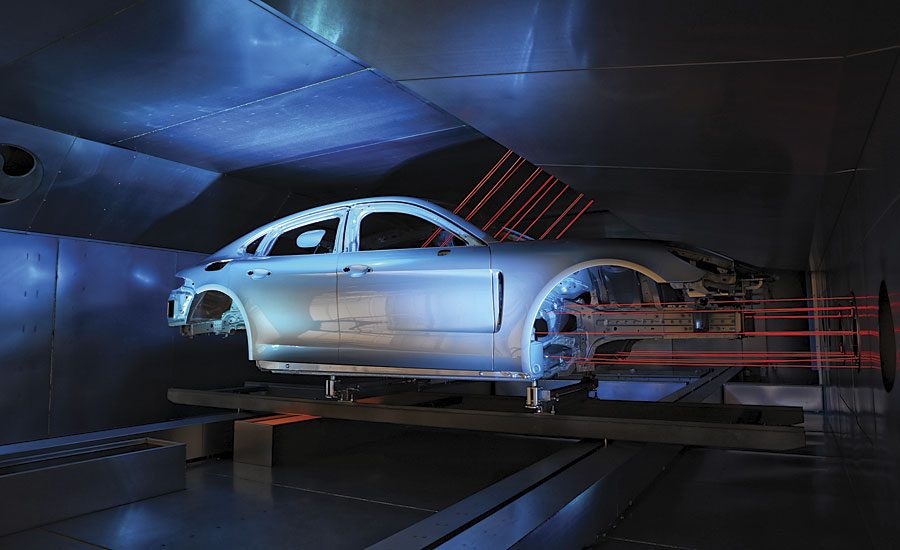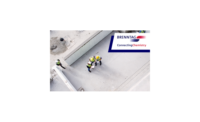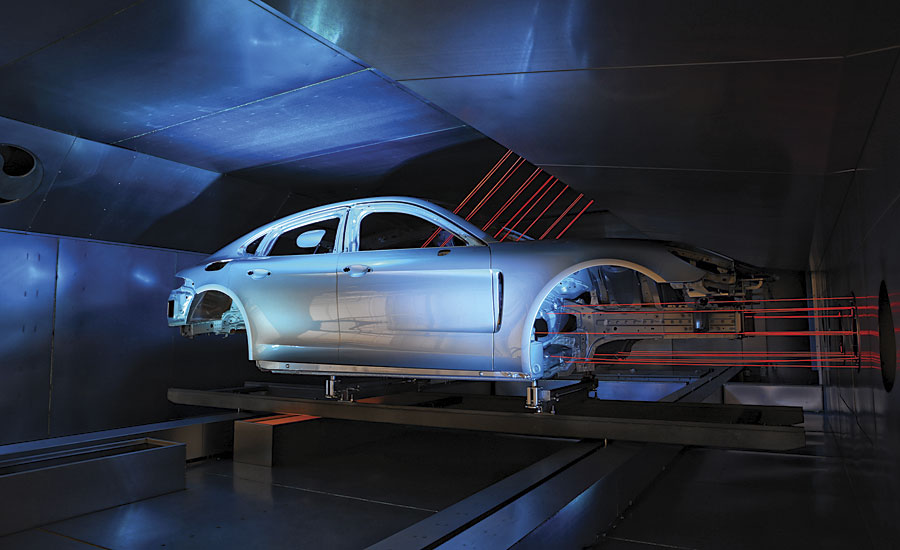Innovative Car Body Curing from the Inside-Out






Oven systems are used in automotive paint shops to thermally cure various materials that are used in the construction or applied to car bodies. These materials include body adhesives used to bond sheet metal layers, various liquid coatings that are applied to protect the body and provide appearance effects, high-viscosity materials that are used to seal seams and dampen vibrations, as well as bake-hardened metals.
Challenges for OEMs
Automotive OEMs are frequently encountering material cure challenges within their paint shop curing ovens. This is due to the design of modern car body construction in which efforts are being made to reduce overall vehicle weight through the use of lighter, high-strength alloyed steels or aluminum alloys as well as polymer structural insert elements. Further, additional structural reinforcements (metal or polymer) are being added to pillar and rocker sections to meet more stringent crash test standards. This is particularly true for electric vehicle design in which it is common to extrude structural elements to rocker and floor pan sections to protect battery cells in the event of a crash. All of these advances in car body design are resulting in increased areas of localized, concentrated thermal mass (i.e. product of mass and material specific heat), requiring more thermal energy to be delivered in order to achieve the necessary material cure.
Current cure oven technology often struggles to deliver enough heat to these high thermal areas, due to how the bodies are processed through the oven. Traditional paint shop oven designs convey painted car bodies in road position through a series of heating zones in which radiant and/or convective energy is directed to exterior surfaces of the body. With this method of heating, minimal thermal energy is directed toward the inner areas of the body, which is where the areas of high thermal mass are typically located. As a result, it is common for automotive OEMs to experience under-cure of materials applied to structural areas of the body. To offset this, OEMs have increased oven operating temperatures, which not only increases energy usage, but can also lead to over-bake of exterior surfaces and, in some extreme cases, structural deformation of exterior surfaces due to varying rates of thermal expansion (due to non-uniform heating) between localized inner and outer areas of the body.
A New Heating Concept
To address these cure issues, Dürr engineers have developed the EcoInCure heating concept in which the painted care bodies are heated from the inside out. This new heating technique is achieved by using a transverse conveyance system in which the car bodies are processed sideways through heating zones, which allows for large convection nozzles to be positioned to direct heated air through the windshield opening of the car into the inner cabin areas as well as directly into the engine compartment areas. A stop-and-go conveyance system is utilized so the car body is placed in optimal position for heating for the maximum amount of time. This results in a minimum amount of convective air flow around the exterior areas of the body and a maximum amount to the inner areas.
There are several benefits to this method of heating. The most important is a significant improvement in the heating rate of areas of high thermal mass, areas of the car body which include rockers, door pillars, floor pans and engine compartment structural elements. Reductions in heat-up time (i.e. time to heat body to cure temperature) have been documented by as much as 30% less on structural areas of the body as compared to a traditional oven. This reduction in body heat up time translates directly to a reduction in required overall oven length, which allows for capital investment savings.
Another key benefit is an improvement in body heating uniformity throughout the entire cure cycle. Reductions of peak temperature differences between inner and outer body panels of 50% have been measured with the EcoIncure. This more uniform heating helps to reduce thermal stresses.
Benefits in topcoat paint appearance are realized from the reduction of air velocity along external painted surfaces. With traditional oven designs, convection air impinges directly onto the wet film paint layer location. With the EcoInCure concept, convection air primarily impinges on the inner, not coated side of the body panels. Wavescan measurements, a method for evaluating coating smoothness, show a reduction of waviness of 50% on vertical surfaces.
Additional benefits include reduction in footprint due to an integrated, single-level heating system in which air circulation boxes are attached directly to the side of the oven with minimum external ductwork. An innovative centralized heating system helps reduce oven equipment complexity and provide potential energy savings of up to 25%. The EcoInCure also incorporates aspects of Industry 4.0, as each body processed is assigned an individual, software-supported quality certificate for the entire drying procedure that accurately tracks the cure data through the oven process. This data is acquired and evaluated using the Dürr software solution iTAC.IoT.Suite
Conclusion
The trend is clear – there are increasing challenges to achieving material cure within paint shop ovens. This trend will continue as body designers look to alternate materials and methods for assembly of future car bodies, particularly electric cars. The EcoInCure has been designed to address these challenges. The product has gained significant interest since its release in 2017. Aside from well-established carmakers like Skoda, which is using EcoInCure in its paint shop in Mlada Boleslav (Czech Republic), there has been significant interest from new automotive manufacturers who are impressed by the benefits in paint quality and production efficiency. Also the EV manufacturer Byton has chosen to use EcoInCure in its new paint shop.
The first three paint shops with this innovative oven will go into operation as early as 2019, and further projects are already being planned. To help OEMs to better evaluate the benefits the EcoInCure technology for their particular cure challenges, Dürr offers lab oven testing in their R&D facility located in Bietigheim-Bissingen, Germany.
For more information, e-mail jim.pakkala@durrusa.com.
Looking for a reprint of this article?
From high-res PDFs to custom plaques, order your copy today!












